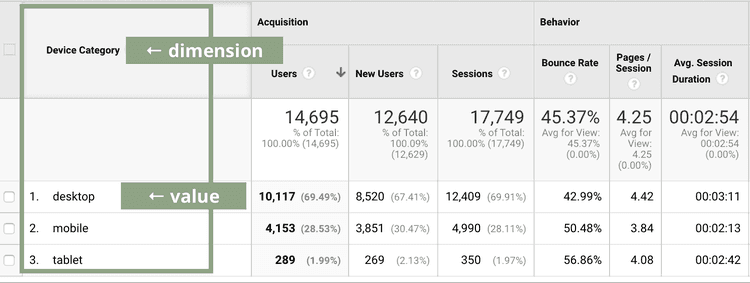The Importance of 'Secondary Dimensions' in Google Analytics: Comprehensive Analysis
The Importance of 'Secondary Dimensions' in Google Analytics: Comprehensive Analysis
Blog Article
Deciphering the Value of Secondary Dimension in Google Analytics: Everything About Its Relevance and Effect
In the world of digital analytics, the application of additional measurements within Google Analytics offers as a pivotal tool for critical deeper layers of information understandings. The relevance of additional measurements lies in their ability to supply a nuanced view of user behavior and communication with a web site or platform.
Understanding Second Measurements in Google Analytics
The understanding of second measurements in Google Analytics is important for obtaining deeper understandings right into individual actions and internet site performance. While key measurements give basic information factors such as web traffic resources and page views, second measurements permit an extra nuanced analysis by offering additional context to these primary metrics. By incorporating secondary measurements, customers can section and filter their data to uncover patterns and patterns that might not be instantly apparent.

Revealing the Advantages of Additional Dimensions
Structure upon the foundational understanding of second measurements in Google Analytics, checking out the advantages they offer reveals important understandings for improving data evaluation and decision-making. By incorporating secondary dimensions, users can delve deeper right into their information, obtaining an extra extensive sight of customer actions, material performance, and various other crucial metrics.
In addition, second measurements supply context to key information, providing added layers of information that can aid in understanding individual communications and preferences. This boosted understanding can direct calculated decision-making, bring about even more targeted marketing projects, site optimizations, and general enhanced performance. Basically, second measurements offer as a powerful device for unlocking much deeper insights and maximizing the utility of Google Analytics for organizations and internet site proprietors.
Leveraging Second Measurements for Enhanced Insights
By harnessing the power of secondary dimensions in Google Analytics, businesses can discover deeper understandings that drive educated strategic and decision-making optimization initiatives. Leveraging secondary measurements enables companies to dig past surface-level information and acquire a much more thorough understanding of individual habits, target market demographics, traffic resources, and site efficiency. For example, by integrating primary measurements like traffic resources with additional measurements such as geographical location or tool group, services can determine which devices or regions are driving the most useful website traffic to their web site.
Moreover, additional measurements enable businesses to section and analyze data better, aiding them recognize patterns, patterns, and possibilities that may have or else gone undetected. By using additional dimensions, organizations can customize their marketing techniques, material, and user experience to much better fulfill the requirements and choices of their target market. Essentially, leveraging second dimensions in Google Analytics encourages companies to make data-driven choices that result in improved efficiency, enhanced ROI, and sustainable growth.
Influence of Secondary Dimensions on Information Evaluation
Enhancing information analysis with the utilization of additional measurements in Google Analytics gives organizations with a deeper understanding of their online performance metrics. By incorporating second measurements, such as time of day, geographical location, or device group, organizations can discover useful insights that may have been neglected with main dimensions alone. This enhanced degree of granularity enables for more precise segmentation of information, allowing companies to recognize patterns, patterns, and correlations that can drive critical decision-making.

Optimizing Prospective: Second Dimensions Methods
The tactical application of additional dimensions in Google Analytics extends past enhancing data analysis; it involves crafting targeted approaches to open the full possibility of important understandings for organization growth. By using secondary dimensions successfully, services can dive much deeper into their internet site web traffic, user behavior, and advertising campaigns to remove actionable insights. One essential technique is to incorporate additional measurements with primary dimensions to get a comprehensive sight of customer interactions. As an example, coupling the main measurement of 'source/medium' with second measurements like 'touchdown page' or 'tool category' can expose which networks are driving web traffic to specific web pages or just how user behavior varies throughout tools.
In addition, making use of additional dimensions to sector data based upon user demographics, actions, or technology can assist businesses moved here tailor their marketing efforts to certain target market sections. This targeted approach can bring about enhanced conversion rates, improved user experiences, and inevitably, boosted ROI. By taking full advantage of the capacity of secondary dimensions in Google Analytics, businesses can make educated decisions, maximize their on the internet existence, and drive sustainable growth.
Verdict
In verdict, second measurements in Google Analytics play an important role in offering deeper understandings and enhancing data analysis. By utilizing additional measurements efficiently, companies can get a much more extensive understanding of individual actions and site efficiency. Integrating second dimensions right into information analysis approaches can lead to even more informed decision-making and boosted total performance. It is important for organizations to leverage the power of secondary measurements to maximize their potential and accomplish better success in their anonymous on the internet ventures (what is a “secondary dimension” in google analytics?).
While key dimensions give fundamental data points such as traffic resources and page views, additional dimensions enable for a more nuanced analysis by offering additional context to these main metrics. By integrating main dimensions like website traffic resources with second measurements such as geographical area or tool group, businesses can identify which tools or areas are driving the most valuable website traffic to their internet site.
By including additional measurements, such as time of day, geographic location, or gadget group, organizations can reveal valuable insights that may have Click Here been forgotten with main measurements alone. One crucial technique is to integrate additional measurements with key dimensions to gain an extensive view of customer interactions. Coupling the main measurement of 'source/medium' with second measurements like 'landing web page' or 'device group' can reveal which networks are driving traffic to particular web pages or exactly how customer actions varies across devices.
Report this page